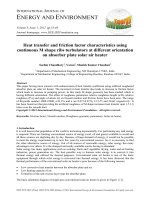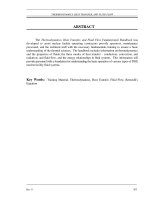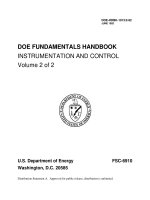DOE-HDBK-1012/1-92JUNE 1992DOE FUNDAMENTALS HANDBOOK THERMODYNAMICS, HEAT TRANSFER, AND FLUID pptx
Bạn đang xem bản rút gọn của tài liệu. Xem và tải ngay bản đầy đủ của tài liệu tại đây (1.88 MB, 138 trang )
DOE-HDBK-1012/1-92
JUNE 1992
DOE FUNDAMENTALS HANDBOOK
THERMODYNAMICS, HEAT TRANSFER,
AND FLUID FLOW
Volume 1 of 3
U.S. Department of Energy FSC-6910
Washington, D.C. 20585
Distribution Statement A. Approved for public release; distribution is unlimited.
This document has been reproduced directly from the best available copy.
Available to DOE and DOE contractors from the Office of Scientific and Technical Information.
P. O. Box 62, Oak Ridge, TN 37831; (615) 576-8401.
Available to the public from the National Technical Information Service, U.S. Department of
Commerce, 5285 Port Royal Rd., Springfield, VA 22161.
Order No. DE92019789
THERMODYNAMICS, HEAT TRANSFER, AND FLUID FLOW
Rev. 0 HT
ABSTRACT
The Thermodynamics, Heat Transfer, and Fluid Flow Fundamentals Handbook was
developed to assist nuclear facility operating contractors provide operators, maintenance
personnel, and the technical staff with the necessary fundamentals training to ensure a basic
understanding of the thermal sciences. The handbook includes information on thermodynamics
and the properties of fluids; the three modes of heat transfer - conduction, convection, and
radiation; and fluid flow, and the energy relationships in fluid systems. This information will
provide personnel with a foundation for understanding the basic operation of various types of DOE
nuclear facility fluid systems.
Key Words: Training Material, Thermodynamics, Heat Transfer, Fluid Flow, Bernoulli's
Equation
THERMODYNAMICS, HEAT TRANSFER, AND FLUID FLOW
Rev. 0 HT
FOREWORD
The Department of Energy (DOE) Fundamentals Handbooks consist of ten academic
subjects, which include Mathematics; Classical Physics; Thermodynamics, Heat Transfer, and Fluid
Flow; Instrumentation and Control; Electrical Science; Material Science; Mechanical Science;
Chemistry; Engineering Symbology, Prints, and Drawings; and Nuclear Physics and Reactor
Theory. The handbooks are provided as an aid to DOE nuclear facility contractors.
These handbooks were first published as Reactor Operator Fundamentals Manuals in 1985
for use by DOE Category A reactors. The subject areas, subject matter content, and level of detail
of the Reactor Operator Fundamentals Manuals was determined from several sources. DOE
Category A reactor training managers determined which materials should be included, and served
as a primary reference in the initial development phase. Training guidelines from the commercial
nuclear power industry, results of job and task analyses, and independent input from contractors
and operations-oriented personnel were all considered and included to some degree in developing
the text material and learning objectives.
The DOE Fundamentals Handbooks represent the needs of various DOE nuclear facilities'
fundamentals training requirements. To increase their applicability to nonreactor nuclear facilities,
the Reactor Operator Fundamentals Manual learning objectives were distributed to the Nuclear
Facility Training Coordination Program Steering Committee for review and comment. To update
their reactor-specific content, DOE Category A reactor training managers also reviewed and
commented on the content. On the basis of feedback from these sources, information that applied
to two or more DOE nuclear facilities was considered generic and was included. The final draft
of each of these handbooks was then reviewed by these two groups. This approach has resulted
in revised modular handbooks that contain sufficient detail such that each facility may adjust the
content to fit their specific needs.
Each handbook contains an abstract, a foreword, an overview, learning objectives, and text
material, and is divided into modules so that content and order may be modified by individual DOE
contractors to suit their specific training needs. Each subject area is supported by a separate
examination bank with an answer key.
The DOE Fundamentals Handbooks have been prepared for the Assistant Secretary for
Nuclear Energy, Office of Nuclear Safety Policy and Standards, by the DOE Training Coordination
Program. This program is managed by EG&G Idaho, Inc.
THERMODYNAMICS, HEAT TRANSFER, AND FLUID FLOW
Rev. 0 HT
OVERVIEW
The Department of Energy Fundamentals Handbook entitled Thermodynamics, Heat
Transfer, and Fluid Flow was prepared as an information resource for personnel who are
responsible for the operation of the Department's nuclear facilities. A basic understanding of the
thermal sciences is necessary for DOE nuclear facility operators, maintenance personnel, and the
technical staff to safely operate and maintain the facility and facility support systems. The
information in the handbook is presented to provide a foundation for applying engineering
concepts to the job. This knowledge will help personnel more fully understand the impact that
their actions may have on the safe and reliable operation of facility components and systems.
The Thermodynamics, Heat Transfer, and Fluid Flow handbook consists of three modules
that are contained in three volumes. The following is a brief description of the information
presented in each module of the handbook.
Volume 1 of 3
Module 1 - Thermodynamics
This module explains the properties of fluids and how those properties are
affected by various processes. The module also explains how energy balances can
be performed on facility systems or components and how efficiency can be
calculated.
Volume 2 of 3
Module 2 - Heat Transfer
This module describes conduction, convection, and radiation heat transfer. The
module also explains how specific parameters can affect the rate of heat transfer.
Volume 3 of 3
Module 3 - Fluid Flow
This module describes the relationship between the different types of energy in a
fluid stream through the use of Bernoulli's equation. The module also discusses
the causes of head loss in fluid systems and what factors affect head loss.
THERMODYNAMICS, HEAT TRANSFER, AND FLUID FLOW
Rev. 0 HT
The information contained in this handbook is by no means all encompassing. An
attempt to present the entire subject of thermodynamics, heat transfer, and fluid flow would be
impractical. However, the Thermodynamics, Heat Transfer, and Fluid Flow handbook does
present enough information to provide the reader with a fundamental knowledge level sufficient
to understand the advanced theoretical concepts presented in other subject areas, and to better
understand basic system and equipment operations.
Department of Energy
Fundamentals Handbook
THERMODYNAMICS, HEAT TRANSFER,
AND FLUID FLOW
Module 1
Thermodynamics
Thermodynamics TABLE OF CONTENTS
TABLE OF CONTENTS
LIST OF FIGURES iv
LIST OF TABLES vii
REFERENCES viii
OBJECTIVES x
THERMODYNAMIC PROPERTIES 1
Mass and Weight 1
Specific Volume 3
Density 3
Specific Gravity 4
Humidity 4
Intensive and Extensive Properties 4
Summary 5
TEMPERATURE AND PRESSURE MEASUREMENTS 6
Temperature 6
Temperature Scales 6
Pressure 9
Pressure Scales 9
Summary 12
ENERGY, WORK, AND HEAT 14
Energy 14
Potential Energy 14
Kinetic Energy 15
Specific Internal Energy 16
Specific P-V Energy 17
Specific Enthalpy 18
Work 18
Heat 19
Entropy 22
Energy and Power Equivalences 23
Summary 25
Rev. 0 Page i HT-01
TABLE OF CONTENTS Thermodynamics
TABLE OF CONTENTS (Cont.)
THERMODYNAMIC SYSTEMS AND PROCESSES 26
Thermodynamic Systems and Surroundings 26
Types of Thermodynamic Systems 27
Thermodynamic Equilibrium 27
Control Volume 27
Steady State 27
Thermodynamic Process 28
Cyclic Process 28
Reversible Process 28
Irreversible Process 28
Adiabatic Process 29
Isentropic Process 29
Polytropic Process 29
Throttling Process 29
Summary 30
CHANGE OF PHASE 31
Classification of Properties 31
Saturation 33
Saturated and Subcooled Liquids 33
Quality 34
Moisture Content 35
Saturated and Superheated Vapors 35
Constant Pressure Heat Addition 35
Critical Point 36
Fusion 36
Sublimation 37
Triple Point 37
Condensation 38
Summary 39
PROPERTY DIAGRAMS AND STEAM TABLES 41
Property Diagrams 41
Pressure-Temperature (P-T) Diagram 42
Pressure-Specific Volume (P-v) Diagram 43
Pressure-Enthalpy (P-h) Diagram 44
Enthalpy-Temperature (h-T) Diagram 45
HT-01 Page ii Rev. 0
Thermodynamics TABLE OF CONTENTS
TABLE OF CONTENTS (Cont.)
Temperature-Entropy (T-s) Diagram 46
Enthalpy-Entropy (h-s) or Mollier Diagram 47
Steam Tables 47
Summary 52
FIRST LAW OF THERMODYNAMICS 53
First Law of Thermodynamics 53
Summary 68
SECOND LAW OF THERMODYNAMICS 69
Second Law of Thermodynamics 69
Entropy 70
Carnot’s Principle 71
Carnot Cycle 71
Diagrams of Ideal and Real Processes 77
Power Plant Components 78
Heat Rejection 85
Typical Steam Cycle 90
Causes of Inefficiency 95
Summary 96
COMPRESSION PROCESSES 97
Boyle’s and Charles’ Laws 97
Ideal Gas Law 98
Fluid 99
Compressibility of Fluids 99
Constant Pressure Process 100
Constant Volume Process 100
Effects of Pressure Changes on Fluid Properties 100
Effects of Temperature Changes on Fluid Properties 101
Summary 102
APPENDIX A Thermodynamics A-1
Rev. 0 Page iii HT-01
LIST OF FIGURES Thermodynamics
LIST OF FIGURES
Figure 1 Comparison of Temperature Scales 7
Figure 2 Pressure Relationships 9
Figure 3 Intensive Properties 32
Figure 4 Piston-Cylinder Arrangement 33
Figure 5 Vapor Pressure Curve 33
Figure 6 T-V Diagram Showing the Saturation Region 34
Figure 7 T-V Diagram 35
Figure 8 Pressure-Temperature Diagram 38
Figure 9 P-T Diagram for Water 42
Figure 10 P-v Diagram for Water 43
Figure 11 P-h Diagram for Water 44
Figure 12 h-T Diagram for Water 45
Figure 13 T-s Diagram for Water 46
Figure 14 First Law of Thermodynamics 55
Figure 15 Control Volume Concepts 56
Figure 16 Open System Control Volumes 57
Figure 17 Open System Control Volumes (Cont.) 58
Figure 18 Mulitple Control Volumes in Same System 58
Figure 19 T-s Diagram with Rankine Cycles 61
HT-01 Page iv Rev. 0
Thermodynamics LIST OF FIGURES
LIST OF FIGURES (Cont.)
Figure 20 Typical Steam Plant Cycle 62
Figure 21 Carnot Cycle Representation 73
Figure 22 Real Process Cycle Compared to Carnot Cycle 75
Figure 23 Control Volume for Second Law Analysis 76
Figure 24 Expansion and Compression Processes on T-s Diagram 78
Figure 25 Expansion and Compression Processes on h-s Diagram 78
Figure 26 Steam Cycle 78
Figure 27 Comparison of Ideal and Actual Turbine Performances 80
Figure 28 Carnot Cycle 85
Figure 29 Carnot Cycle vs. Typical Power Cycle Available Energy 86
Figure 30 Ideal Carnot Cycle 87
Figure 31 Rankine Cycle 88
Figure 32 Rankine Cycle with Real v.s. Ideal 89
Figure 33 Rankine Cycle Efficiencies T-s 89
Figure 34 h-s Diagram 90
Figure 35 Typical Steam Cycle 91
Figure 36 Steam Cycle (Ideal) 92
Figure 37 Steam Cycle (Real) 92
Figure 38 Mollier Diagram 93
Figure 39 Ideal Gas Constant Values 98
Figure 40 Pressure-Volume Diagram 99
Rev. 0 Page v HT-01
LIST OF FIGURES Thermodynamics
LIST OF FIGURES (Cont.)
Figure A-1 Mollier Diagram A-1
Figure A-2 Sample Steam Tables A-3
Figure A-3 Thermodynamic Properties of Mercury A-5
Figure A-4 Thermodynamic Properties of CO
2
A-7
HT-01 Page vi Rev. 0
Thermodynamics LIST OF TABLES
LIST OF TABLES
NONE
Rev. 0 Page vii HT-01
REFERENCES Thermodynamics
REFERENCES
VanWylen, G. J. and Sonntag, R. E., Fundamentals of Classical Thermodynamics
SI Version, 2nd Edition, John Wiley and Sons, New York, ISBN 0-471-04188-2.
Kreith, Frank, Principles of Heat Transfer, 3rd Edition, Intext Press, Inc., New
York, ISBN 0-7002-2422-X.
Holman, J. P., Thermodynamics, McGraw-Hill, New York.
Streeter, Victor, L., Fluid Mechanics, 5th Edition, McGraw-Hill, New York, ISBN
07-062191-9.
Rynolds, W. C. and Perkins, H. C., Engineering Thermodynamics, 2nd Edition,
McGraw-Hill, New York, ISBN 0-07-052046-1.
Meriam, J. L., Engineering Mechanics Statics and Dynamics, John Wiley and
Sons, New York, ISBN 0-471-01979-8.
Schneider, P. J. Conduction Heat Transfer, Addison-Wesley Pub. Co., California.
Holman, J. P., Heat Transfer, 3rd Edition, McGraw-Hill, New York.
Knudsen, J. G. and Katz, D. L., Fluid Dynamics and Heat Transfer, McGraw-Hill,
New York.
Kays, W. and London, A. L., Compact Heat Exchangers, 2nd Edition, McGraw-
Hill, New York.
Weibelt, J. A., Engineering Radiation Heat Transfer, Holt, Rinehart and Winston
Publish., New York.
Sparrow, E. M. and Cess, R. E., Radiation Heat Transfer, Brooks/Cole Publish.
Co., Belmont, California.
Hamilton, D. C. and Morgan, N. R., Radiant-Interchange Configuration Factors,
Tech. Note 2836, National Advisory Committee for Aeronautics.
HT-01 Page viii Rev. 0
Thermodynamics REFERENCES
REFERENCES (Cont.)
McDonald, A. T. and Fox, R. W., Introduction to Fluid mechanics, 2nd Edition,
John Wiley and Sons, New York, ISBN 0-471-01909-7.
Zucrow, M. J. and Hoffman, J. D., Gas Dynamics Vol.b1, John Wiley and Sons,
New York, ISBN 0-471-98440-X.
Crane Company, Flow of Fluids Through Valves, Fittings, and Pipe, Crane Co.
Technical Paper No. 410, Chicago, Illinois, 1957.
Esposito, Anthony, Fluid Power with Applications, Prentice-Hall, Inc., New
Jersey, ISBN 0-13-322701-4.
Beckwith, T. G. and Buck, N. L., Mechanical Measurements, Addison-Wesley
Publish Co., California.
Wallis, Graham, One-Dimensional Two-Phase Flow, McGraw-Hill, New York,
1969.
Kays, W. and Crawford, M. E., Convective Heat and Mass Transfer, McGraw-
Hill, New York, ISBN 0-07-03345-9.
Collier, J. G., Convective Boiling and Condensation, McGraw-Hill, New York,
ISBN 07-084402-X.
Academic Program for Nuclear Power Plant Personnel, Volumes III and IV,
Columbia, MD: General Physics Corporation, Library of Congress Card
#A326517, 1982.
Faires, Virgel Moring and Simmang, Clifford Max, Thermodynamics, MacMillan
Publishing Co. Inc., New York.
Rev. 0 Page ix HT-01
OBJECTIVES Thermodynamics
TERMINAL OBJECTIVE
1.0 Given operating conditions of a system, EVALUATE the thermodynamic state of the
system.
ENABLING OBJECTIVES
1.1 DEFINE the following properties:
a. Specific volume
b. Density
c. Specific gravity
d. Humidity
1.2 DESCRIBE the following classifications of thermodynamic properties:
a. Intensive properties
b. Extensive properties
1.3 DEFINE the thermodynamic properties temperature and pressure.
1.4 DESCRIBE the Fahrenheit, Celsius, Kelvin, and Rankine temperature scales including:
a. Absolute zero temperature
b. The freezing point of water at atmospheric pressure
c. The boiling point of water at atmospheric pressure
1.5 CONVERT temperatures between the Fahrenheit, Celsius, Kelvin, and Rankine scales.
1.6 DESCRIBE the relationship between absolute pressure, gauge pressure, and vacuum.
1.7 CONVERT pressures between the following units:
a. Pounds per square inch
b. Inches of water
c. Inches of mercury
d. Millimeters of mercury
e. Microns of mercury
1.8 DEFINE the following:
a. Heat
b. Latent heat
c. Sensible heat
d. Unit used to measure heat
HT-01 Page x Rev. 0
Thermodynamics OBJECTIVES
ENABLING OBJECTIVES (Cont.)
1.9 DEFINE the following thermodynamic properties:
a. Specific enthalpy
b. Entropy
1.10 DESCRIBE the following types of thermodynamic systems:
a. Isolated system
b. Closed system
c. Open system
1.11 DEFINE the following terms concerning thermodynamic systems:
a. Thermodynamic surroundings
b. Thermodynamic equilibrium
c. Control volume
d. Steady-state
1.12 DESCRIBE the following terms concerning thermodynamic processes:
a. Thermodynamic process
b. Cyclic process
c. Reversible process
d. Irreversible process
e. Adiabatic process
f. Isentropic process
g. Throttling process
h. Polytropic process
1.13 DISTINGUISH between intensive and extensive properties.
1.14 DEFINE the following terms:
a. Saturation
b. Subcooled liquid
c. Superheated vapor
d. Critical Point
e. Triple Point
f. Vapor pressure curve
g. Quality
h. Moisture content
1.15 DESCRIBE the processes of sublimation, vaporization, condensation, and fusion.
Rev. 0 Page xi HT-01
OBJECTIVES Thermodynamics
ENABLING OBJECTIVES (Cont.)
1.16 Given a Mollier diagram and sufficient information to indicate the state of the fluid,
DETERMINE any unknown properties for the fluid.
1.17 Given a set of steam tables and sufficient information to indicate the state of the fluid,
DETERMINE any unknown properties for the fluid.
1.18 DETERMINE the change in the enthalpy of a fluid as it passes through a system
component, given the state of the fluid at the inlet and outlet of the component and either
steam tables or a Mollier diagram.
1.19 STATE the First Law of Thermodynamics.
1.20 Using the First Law of Thermodynamics, ANALYZE an open system including all
energy transfer processes crossing the boundaries.
1.21 Using the First Law of Thermodynamics, ANALYZE cyclic processes for a
thermodynamic system.
1.22 Given a defined system, PERFORM energy balances on all major components in the
system.
1.23 Given a heat exchanger, PERFORM an energy balance across the two sides of the heat
exchanger.
1.24 IDENTIFY the path(s) on a T-s diagram that represents the thermodynamic processes
occurring in a fluid system.
1.25 STATE the Second Law of Thermodynamics.
1.26 Using the Second Law of Thermodynamics, DETERMINE the maximum possible
efficiency of a system.
1.27 Given a thermodynamic system, CONDUCT an analysis using the Second Law of
Thermodynamics.
1.28 Given a thermodynamic system, DESCRIBE the method used to determine:
a. The maximum efficiency of the system
b. The efficiency of the components within the system
HT-01 Page xii Rev. 0
Thermodynamics OBJECTIVES
ENABLING OBJECTIVES (Cont.)
1.29 DIFFERENTIATE between the path for an ideal process and that for a real process on
a T-s or h-s diagram.
1.30 Given a T-s or h-s diagram for a system EVALUATE:
a. System efficiencies
b. Component efficiencies
1.31 DESCRIBE how individual factors affect system or component efficiency.
1.32 Apply the ideal gas laws to SOLVE for the unknown pressure, temperature, or volume.
1.33 DESCRIBE when a fluid may be considered to be incompressible.
1.34 CALCULATE the work done in constant pressure and constant volume processes.
1.35 DESCRIBE the effects of pressure changes on confined fluids.
1.36 DESCRIBE the effects of temperature changes on confined fluids.
Rev. 0 Page xiii HT-01









